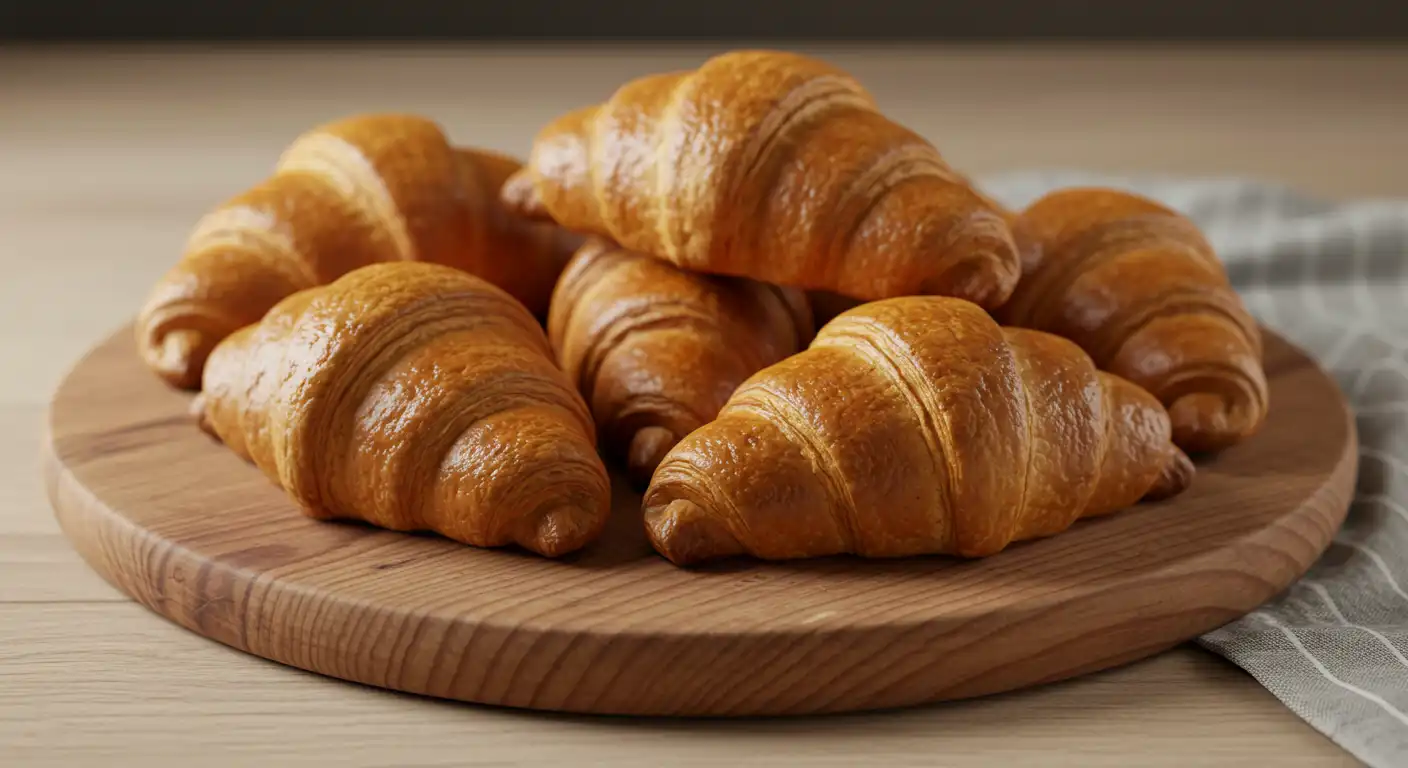There’s something truly magical about the aroma of freshly baked pastries wafting through the kitchen in the early morning. I remember the first time my family and I made Gipfeli together—a quiet Sunday morning transformed into an unforgettable culinary adventure. The golden, flaky layers melted in our mouths, perfectly complemented by homemade berry jam and a slather of creamy butter. Gipfeli, the Swiss take on croissants, is a staple in Switzerland’s breakfast culture, and once you master this recipe, you’ll never look back. Let’s dive into the art of crafting these exquisite Swiss crescent-shaped pastries.
Table of Contents
What is Gipfeli? (The Swiss Take on Croissants)
The origins of Swiss Gipfeli and how they differ from traditional French croissants.
The Gipfeli recipe has deep roots in Swiss baking traditions, offering a unique twist on the classic buttery croissants found in France. Unlike the rich, ultra-flaky layers of a flaky croissant recipe, Swiss Gipfeli is slightly denser with a more bread-like crumb, making them a beloved Swiss breakfast bread. While the French rely heavily on laminated dough with a high butter content, a Swiss croissant recipe incorporates a subtler richness, often with less butter. Learning how to make Gipfeli means embracing a balance between airy texture and heartiness, making this homemade Gipfeli a staple in any Swiss pastry recipe collection.
Why Gipfeli is a popular Swiss breakfast pastry.
A staple in Swiss cafés and bakeries, breakfast pastries like Gipfeli are cherished for their delicate texture and subtle sweetness. The appeal of a Swiss pastry recipe lies in its perfect balance—less buttery than buttery croissants, yet still offering a tender, flaky bite. Many Swiss households enjoy them warm with butter and jam, making them an essential Swiss breakfast bread. The simplicity of a gipfeli recipe allows it to pair effortlessly with coffee or tea, enhancing the morning ritual. Whether using a flaky croissant recipe or a more traditional dough, knowing how to make Gipfeli ensures a satisfying, homemade indulgence.
The key ingredients that make Gipfeli unique :
The secret to an authentic gipfeli recipe lies in its delicate combination of rich butter, airy yeast dough, and layered puff pastry croissants technique. Unlike a traditional Swiss croissant recipe, Gipfeli is less buttery yet maintains a tender, golden crust. The yeast dough provides a light, pillowy texture, while careful lamination creates the characteristic flakiness found in a flaky croissant recipe. High-quality butter is essential for achieving the melt-in-your-mouth sensation that defines these beloved breakfast pastries. Mastering how to make Gipfeli at home requires patience, but the result is a truly satisfying Swiss pastry recipe perfect for any morning spread.
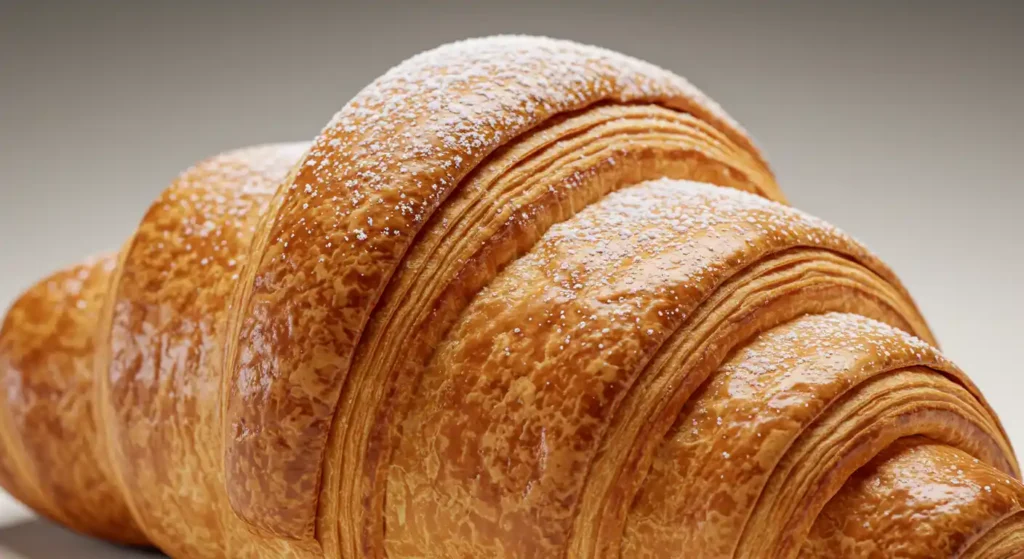
Ingredients You Need for the Perfect Gipfeli
Essential ingredients for homemade Gipfeli :
When preparing a gipfeli recipe, the foundation of this beloved Swiss pastry is built on a handful of essential ingredients. Flour is the primary base, contributing structure to the dough, while yeast provides the necessary rise for lightness. Butter is a crucial component, ensuring the signature richness and flaky texture, akin to a buttery croissant. Milk and eggs further enrich the dough, enhancing its flavor and golden hue when baked. For those seeking an easy yet authentic experience, learning how to make Gipfeli from scratch is a rewarding process that rivals the complexity of a flaky croissant recipe. This traditional Swiss croissant recipe yields breakfast pastries that rival any Swiss breakfast bread. Perfect for those who love puff pastry croissants, it guarantees indulgence with every bite.
Why high-quality butter is key for flaky layers.
The secret to achieving perfectly flaky layers in gipfeli lies in the quality of the butter used. High-quality butter contains a higher fat content, which is crucial for creating the delicate, flaky texture synonymous with buttery croissants. When following a Swiss croissant recipe or learning how to make Gipfeli, incorporating premium butter ensures that the dough’s lamination process — the folding of layers — remains precise and results in tender, airy layers. This is especially important for those seeking a flawless flaky croissant recipe. Using top-notch butter also elevates the flavor, making these breakfast pastries a standout, whether enjoyed as part of Swiss breakfast bread or puff pastry croissants.
Alternative ingredient options :
For those looking to save time without sacrificing taste, store-bought puff pastry is an excellent alternative when preparing a gipfeli recipe. It simplifies the process of making homemade Gipfeli by eliminating the need to create a laminated dough from scratch. This shortcut is perfect for an easy croissant recipe or a Swiss croissant recipe when you’re craving buttery croissants in a hurry. While flaky croissant recipes often rely on meticulous dough folding, puff pastry croissants provide a quicker, yet still delicious, option for making breakfast pastries. Whether serving as Swiss breakfast bread or a delightful treat, the result is still rich and satisfying.
Step-by-Step Guide: How to Make Swiss Gipfeli
Preparing the Dough :
When preparing the dough for a gipfeli recipe, the key to achieving a light, airy texture is the careful process of mixing and proofing. Start by combining the ingredients gently, ensuring the yeast is activated but not overworked. Allow the dough to rise in a warm environment, giving it time to develop flavor and structure. For a Swiss croissant recipe, this proofing step is essential for creating the perfect balance of softness and flakiness. Whether making homemade Gipfeli or a flaky croissant recipe, patience is crucial. This process also contributes to the delicious layers found in buttery croissants and puff pastry croissants, ensuring they rise beautifully when baked. Properly proofed dough ensures your breakfast pastries will be light, tender, and a perfect match for any Swiss breakfast bread.
Rolling and Folding :
Rolling and folding are critical techniques in creating the signature buttery layers of gipfeli. In a Swiss croissant recipe, this step ensures the dough remains light and flaky. Begin by rolling the dough into a thin sheet, then fold it repeatedly to lock in the butter, a process that builds the delicate layers. How to make Gipfeli requires precision to ensure each fold is even and tight, which results in the perfect texture. Whether preparing homemade Gipfeli or a flaky croissant recipe, these techniques are crucial for creating irresistibly buttery croissants. The same process applies to puff pastry croissants and other breakfast pastries, where layers are the key to achieving a melt-in-your-mouth experience.
Shaping the Gipfeli :
Shaping the gipfeli into its iconic crescent form requires precision and care. Once the dough has been rolled out and cut into triangles, gently roll each piece from the base toward the tip, ensuring a tight, uniform shape. The key is to maintain consistent tension, which ensures the classic, elongated crescent. For a Swiss croissant recipe, this step is especially important, as it contributes to the airy, flaky layers that define buttery croissants. Whether you’re crafting homemade Gipfeli or following a flaky croissant recipe, this shaping technique guarantees that your breakfast pastries will rise beautifully, offering the perfect bite every time, akin to Swiss breakfast bread or even puff pastry croissants.
Baking Tips :
To achieve the perfect gipfeli, attention to detail during baking is essential. First, preheat your oven to a high temperature (around 375°F to 400°F) to ensure a quick rise and a golden, crisp crust. Brushing the rolled gipfeli with an egg wash before baking gives them a beautiful, glossy finish, enhancing the visual appeal of your Swiss croissant recipe. For the best texture, avoid overcrowding the baking sheet, as proper airflow is crucial to prevent sogginess. How to make Gipfeli with a light, flaky texture is all about balance—whether you’re making homemade Gipfeli, buttery croissants, or puff pastry croissants, careful temperature control ensures your breakfast pastries are perfectly crisp and never soggy.
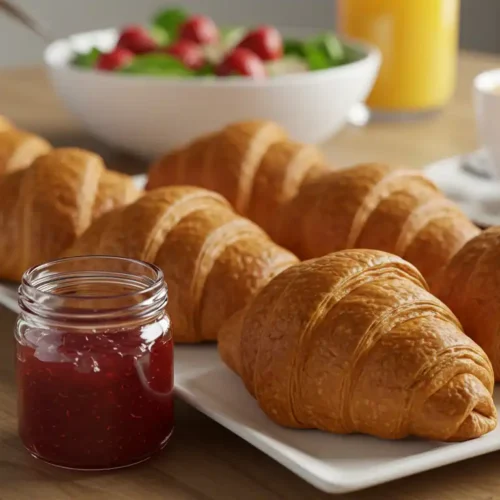
Gipfeli (Swiss Crescent-Shaped Pastries)
Equipment
- Stand mixer with a dough hook (optional)
- Rolling Pin
- Baking sheets
- Parchment paper
Ingredients
For the Dough:
- 2 ¼ teaspoons 7 grams active dry yeast
- 1 ⅓ cups 315 milliliters lukewarm milk (105-115˚F / 40-46˚C)
- 4 cups 500 grams all-purpose flour
- 3 tablespoons 38 grams granulated sugar
- 1 ½ teaspoons salt
- 1 large egg
- For the Butter Block:
- 1 cup 226 grams unsalted butter, chilled
For Assembly:
- 1 egg yolk
- 1 tablespoon 15 milliliters milk
Instructions
Prepare the Dough:
- Activate yeast in lukewarm milk, then combine with flour, sugar, salt, and egg to form dough. Knead until smooth and rest until doubled in size.
Prepare the Butter Block:
- Roll chilled butter into a square and refrigerate until slightly pliable.
Laminate the Dough:
- Roll dough into a rectangle, place butter inside, fold, and refrigerate in stages (three rounds of folding and chilling).
Shape the Gipfeli:
- Roll dough into triangles, cut at the center, roll up, and shape into crescents.
Proof and Bake:
- Let shaped pastries rest until puffed, then brush with egg wash and bake at two temperatures for golden, crispy crescents.
Notes
- The butter should be pliable but not completely solid during the lamination process.
- Ensure the dough rests sufficiently for the best rise and flakiness.
- These pastries are best served warm, with butter and jam.
Pro Tips for Flaky, Buttery, and Perfect Gipfeli
The secret to perfect dough elasticity.
The secret to perfect dough elasticity lies in the careful balance of ingredients and technique. For a gipfeli recipe, the flour type and hydration are critical; bread flour, with its higher protein content, creates the ideal structure for elasticity. Kneading the dough until smooth activates the gluten, which helps it stretch without tearing. During how to make Gipfeli, resting the dough allows it to relax, making it easier to roll into the desired shapes. This is particularly important for Swiss croissant recipes and homemade Gipfeli, ensuring that your buttery croissants or flaky croissant recipes maintain their light, airy texture. Whether baking Swiss breakfast bread or puff pastry croissants, the key is allowing the dough to develop the right elasticity for the best results in breakfast pastries.
Why chilling the dough makes a huge difference.
Chilling the dough is a crucial step that enhances both texture and flavor in any gipfeli recipe. The process allows the fat, usually buttery croissants, to firm up, ensuring that it doesn’t melt into the dough prematurely. When making homemade Gipfeli or following a Swiss croissant recipe, refrigerating the dough helps maintain the delicate layers during rolling and folding, crucial for creating that signature flakiness. Without proper chilling, the dough can become too soft, leading to a dense, unappetizing result. Whether crafting a flaky croissant recipe or puff pastry croissants, chilled dough ensures perfect breakfast pastries, with crisp, airy layers that are both beautiful and delicious, much like traditional Swiss breakfast bread.
Common mistakes to avoid :
When making gipfeli, there are a few common mistakes to avoid. Over-kneading the dough is a frequent error, as it can make the texture too tough rather than light and airy. Properly proofing the dough is also crucial; rushing this step can result in dense breakfast pastries instead of the fluffy layers you seek. Whether following a Swiss croissant recipe or learning how to make Gipfeli, ensuring the dough rests long enough to rise properly is key. Failing to chill the dough can also compromise the flakiness of your flaky croissant recipe or buttery croissants. Take your time, and your homemade Gipfeli will turn out perfect every time, resembling the best Swiss breakfast bread or puff pastry croissants.
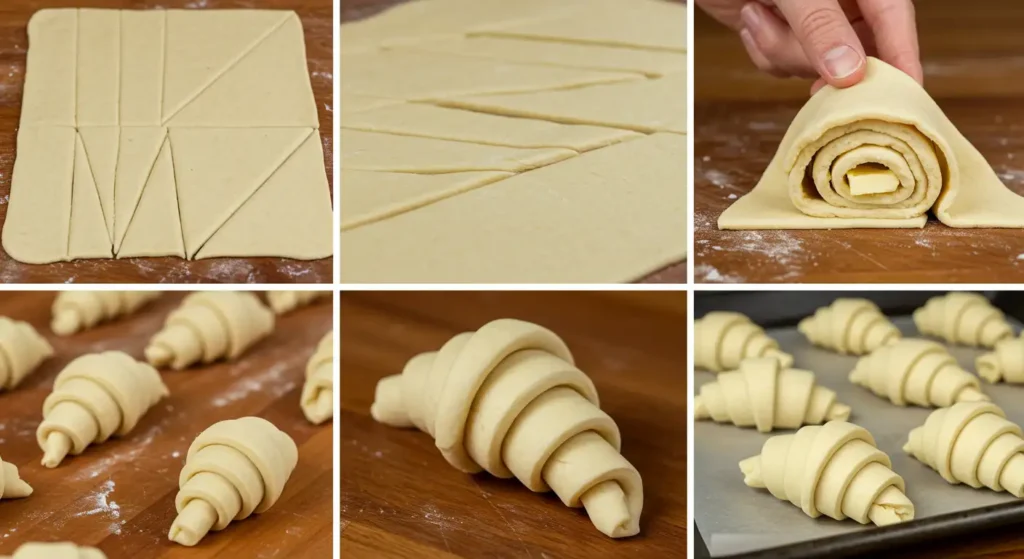
Serving & Storing Your Homemade Gipfeli
Best ways to enjoy freshly baked Gipfeli :
Freshly baked gipfeli is a delight on its own, but there are several ways to elevate this classic treat. Spread a generous layer of butter on the warm pastry for a rich, melt-in-your-mouth experience. For a sweeter option, a dollop of jam adds a fruity contrast that complements the buttery layers. For those who enjoy savory flavors, pairing homemade Gipfeli with Swiss cheese provides a perfect balance. Whether enjoying it with Swiss croissant recipe influences or as part of traditional Swiss breakfast bread, breakfast pastries like these can also be served alongside a hot cup of coffee. Simply irresistible!
How to store and reheat without losing flakiness.
To preserve the delicate flakiness of gipfeli, proper storage is key. After baking, allow the homemade Gipfeli to cool completely before storing them in an airtight container at room temperature. This prevents moisture from seeping in and affecting their texture. When reheating, avoid microwaving, as it can make them soggy. Instead, wrap the Swiss pastry in foil and place it in a preheated oven at 350°F for about 5-10 minutes. This method restores the crisp, flaky croissant recipe texture and enhances the buttery layers. Whether enjoying breakfast pastries or puff pastry croissants, this technique will keep them fresh and crisp.
Freezing tips for make-ahead Gipfeli.
Freezing is an excellent option for make-ahead gipfeli. To preserve their freshness, follow the steps carefully. After shaping the dough but before baking, place the unbaked homemade Gipfeli on a baking sheet and freeze them individually. After freezing, place them in a freezer-safe bag or container for storage. When you’re ready to enjoy, simply bake the Swiss pastry directly from the freezer, adjusting the baking time slightly. This method works perfectly with a Swiss croissant recipe or flaky croissant recipe, ensuring that the buttery croissants maintain their texture and flavor. Whether making puff pastry croissants or other breakfast pastries, these tips ensure a delicious treat, just like fresh Swiss breakfast bread.
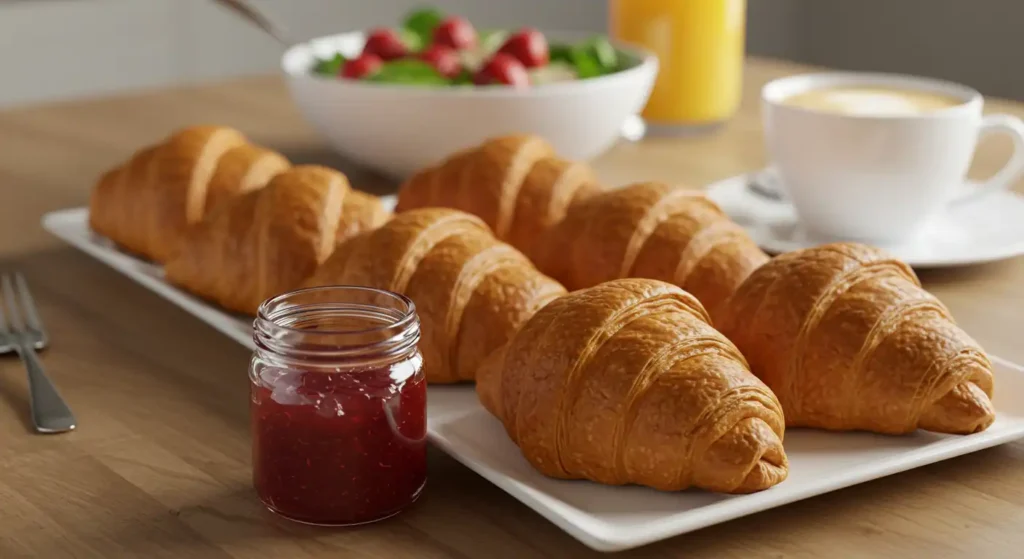
Frequently Asked Questions:
How does a gipfeli differ from a traditional croissant?
A gipfeli is a Swiss pastry similar to a croissant but typically smaller and slightly sweeter. The dough for gipfeli is less buttery than a croissant, resulting in a denser texture. Additionally, gipfeli often has a more subtle flavor profile, sometimes featuring almond or sugar glazing.
What’s the key to making a perfect croissant?
The secret to a perfect croissant lies in the lamination process, where layers of butter and dough are carefully folded to create flakiness. Proper fermentation and proofing are also essential to achieve the desired airy texture. Consistent oven temperature during baking ensures the perfect golden-brown, crisp exterior.
What common errors should be avoided when baking croissants?
Over-kneading the dough can make it tough, leading to less flakiness. Additionally, insufficient proofing can result in dense, under-risen croissants. Lastly, not chilling the dough properly can cause the butter to melt too early, resulting in a greasy, uneven texture.
Which flour is best suited for croissant dough?
Bread flour, with its higher protein content, is ideal for croissants as it creates a stronger gluten structure that supports the lamination process. This results in a crisp, flaky texture. However, some recipes may call for a mix of bread and all-purpose flour to strike the right balance of tenderness and strength.
Which type of butter yields the best croissants?
European-style butter, with a higher fat content (around 82%), is considered the best choice for croissants. It produces a more delicate and flavorful dough, contributing to a superior, melt-in-your-mouth texture. The butter should be cold and firm when incorporated into the dough for optimal results.
What are the effects of over-folding croissant dough?
Over-folding croissant dough can result in too many layers, making the pastry dense rather than light and flaky. It can also cause the butter to break down and melt into the dough, losing the signature texture. Careful attention to folding and resting the dough is essential for maintaining the delicate layers.
What causes a croissant to become soggy?
A croissant becomes soggy when excess moisture is trapped within the layers, often due to insufficient baking or improper storage. If the dough is over-hydrated or not baked at a high enough temperature, the butter and dough don’t form the crisp layers necessary for a flaky texture. Storing croissants improperly can also lead to a loss of crispness.
How thin should croissant dough be rolled for the best results?
Croissant dough should be rolled to about 1/8-inch thick for ideal flakiness. This allows the butter layers to remain distinct and creates the necessary volume when the dough rises. Any thicker and the croissants may be dense; thinner dough could result in overly fragile layers.
Is crescent dough equivalent to puff pastry dough?
No, crescent dough is not the same as puff pastry dough. Crescent dough typically has yeast, which makes it rise, whereas puff pastry relies on layers of butter and dough without yeast for its characteristic puff and flakiness. Puff pastry creates a lighter, airier texture compared to the denser, slightly sweeter crescent dough.
Conclusion
Making gipfeli at home is simpler than you might think. With a few basic ingredients and some patience, you can create your own batch of homemade Gipfeli that rivals any bakery’s offerings. Whether you’re following a Swiss croissant recipe or an easy croissant recipe, the process of layering butter and dough results in a deliciously flaky buttery pastry. Don’t hesitate to try this Swiss pastry recipe in your own kitchen, and feel free to share your results! We’d love to hear about your favorite Swiss breakfast bread experiences—comment below or share your tips for the perfect breakfast pastries!

